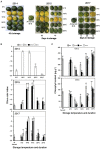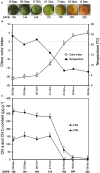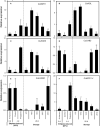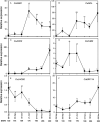Examining the Role of Low Temperature in Satsuma Mandarin Fruit Peel Degreening via Comparative Physiological and Transcriptomic Analysis
- PMID: 35909736
- PMCID: PMC9328020
- DOI: 10.3389/fpls.2022.918226
Examining the Role of Low Temperature in Satsuma Mandarin Fruit Peel Degreening via Comparative Physiological and Transcriptomic Analysis
Abstract
Peel degreening is the most conspicuous aspect of fruit ripening in many citrus fruits because of its importance for marketability. In this study, peel degreening in response to propylene (an ethylene analog) and at varying storage temperatures was characterized in Satsuma mandarin (Citrus unshiu Marc.) fruit. Propylene treatment triggered rapid peel degreening (within 4-6 days), indicated by an increase in the citrus color index (CCI) and chlorophyll loss. Peel degreening was also observed in fruit at 10°C and 15°C after 28-42 days, with gradual CCI increase and chlorophyll reduction. However, fruit at 5°C, 20°C, and 25°C remained green, and no substantial changes in peel CCI and chlorophyll content were recorded during the 42-day storage duration. The transcriptomes of peels of fruit treated with propylene for 4 days and those stored at varying temperatures for 28 days were then analyzed by RNA-Seq. We identified three categories of differentially expressed genes that were regulated by (i) propylene (and by analogy, ethylene) alone, (ii) low temperature (5°C, 10°C, or 15°C vs. 25°C) alone, and (iii) either propylene or low temperature. Gene-encoding proteins associated with chlorophyll degradation (such as CuSGR1, CuNOL, CuACD2, CuCAB2, and CuLHCB2) and a transcription factor (CuERF114) were differentially expressed by propylene or low temperature. To further examine temperature-induced pathways, we also monitored gene expression during on-tree fruit maturation vs. postharvest. The onset of on-tree peel degreening coincided with autumnal drops in field temperatures, and it was accompanied by differential expression of low temperature-regulated genes. On the contrary, genes that were exclusively regulated by propylene (such as CuCOPT1 and CuPOX-A2) displayed insignificant expression changes during on-tree peel degreening. These findings indicate that low temperatures could be involved in the fruit ripening-related peel degreening independently of ethylene.
Keywords: RNA-Seq; chlorophyll; citrus; degreening; ethylene; on-tree; storage.
Copyright © 2022 Mitalo, Asiche, Kang, Ezura, Akagi, Kubo and Ushijima.
Conflict of interest statement
WA is employed by Del Monte Kenya Ltd. The remaining authors declare that the study was conducted in the absence of any commercial or financial relationships that could be construed as a potential conflict of interest.
Figures







Similar articles
-
Low temperature modulates natural peel degreening in lemon fruit independently of endogenous ethylene.J Exp Bot. 2020 Aug 6;71(16):4778-4796. doi: 10.1093/jxb/eraa206. J Exp Bot. 2020. PMID: 32374848 Free PMC article.
-
Low and high storage temperature inhibited the coloration of mandarin fruit (Citrus unshiu Marc.) with different mechanism.J Sci Food Agric. 2022 Dec;102(15):6930-6941. doi: 10.1002/jsfa.12054. Epub 2022 Jun 27. J Sci Food Agric. 2022. PMID: 35674404
-
Effects of elevated CO2 on pigment metabolism of postharvest mandarin fruit for degreening.Food Chem. 2020 Jul 15;318:126462. doi: 10.1016/j.foodchem.2020.126462. Epub 2020 Feb 22. Food Chem. 2020. PMID: 32126463
-
Altered sensitivity to ethylene in 'Tardivo', a late-ripening mutant of Clementine mandarin.Physiol Plant. 2014 Aug;151(4):507-21. doi: 10.1111/ppl.12133. Epub 2013 Dec 29. Physiol Plant. 2014. PMID: 24372483
-
Taste and aroma of fresh and stored mandarins.J Sci Food Agric. 2011 Jan 15;91(1):14-23. doi: 10.1002/jsfa.4146. Epub 2010 Sep 2. J Sci Food Agric. 2011. PMID: 20812381 Review.
Cited by
-
Apple polyphenols delay postharvest senescence and quality deterioration of 'Jinshayou' pummelo fruit during storage.Front Plant Sci. 2023 Jan 19;13:1117106. doi: 10.3389/fpls.2022.1117106. eCollection 2022. Front Plant Sci. 2023. PMID: 36743559 Free PMC article.
-
Transcriptomic analysis in tomato fruit reveals divergences in genes involved in cold stress response and fruit ripening.Front Plant Sci. 2023 Jul 28;14:1227349. doi: 10.3389/fpls.2023.1227349. eCollection 2023. Front Plant Sci. 2023. PMID: 37575935 Free PMC article.
-
Maintenance of postharvest storability and overall quality of 'Jinshayou' pummelo fruit by salicylic acid treatment.Front Plant Sci. 2023 Jan 11;13:1086375. doi: 10.3389/fpls.2022.1086375. eCollection 2022. Front Plant Sci. 2023. PMID: 36714761 Free PMC article.
References
-
- Asiche W. O., Mitalo O. W., Kasahara Y., Tosa Y., Mworia E. G., Owino W. O., et al. . (2018). Comparative transcriptome analysis reveals distinct ethylene-independent regulation of ripening in response to low temperature in kiwifruit. BMC Plant Biol. 18, 47. 10.1186/s12870-018-1264-y - DOI - PMC - PubMed
-
- Barry C. S. (2009). The stay-green revolution: recent progress in deciphering the mechanisms of chlorophyll degradation in higher plants. Plant Sci. 176, 325–333. 10.1016/j.plantsci.2008.12.013 - DOI
-
- Carmona L., Rodrigo M. J., Zacarías L. (2012b). Exploring the involvement of ethylene in the regulation of color changes in citrus fruit. Acta Hortic. 934, 879–885. 10.17660/ActaHortic.2012.934.117 - DOI
-
- Carmona L., Zacarías L., Rodrigo M. J. (2012a). Stimulation of coloration and carotenoid biosynthesis during postharvest storage of ‘Navelina' orange fruit at 12°C. Postharvest Biol. Technol. 74, 108–117. 10.1016/j.postharvbio.2012.06.021 - DOI
LinkOut - more resources
Full Text Sources

